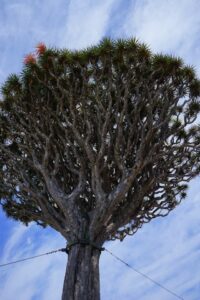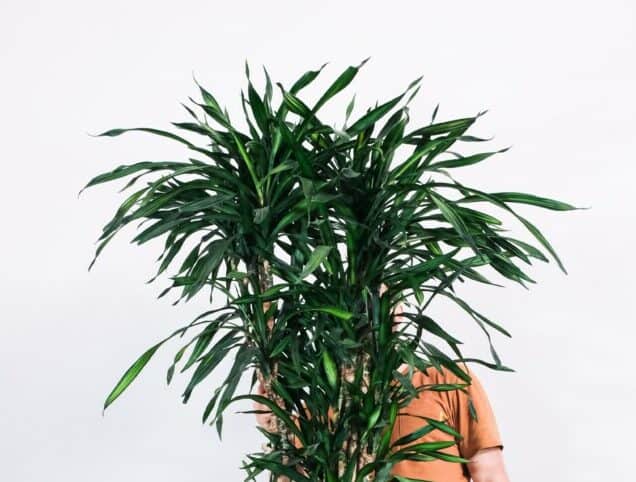Some links in the post are affiliate links and I get a commission from purchases made through some links found in the post.
The Dracaena Marginata (dragon tree) is a tropical plant. So, it was not a surprise when I learned that it needed bright light to thrive. What else could I expect?
The plant is native to Madagascar, an island. What surprised me was that some gardeners still managed to grow beautiful dragon trees in partial shade.
I remember seeing one gardener whose home was partially lit at best. Yet, the dragon tree still managed to stand out in that room.
And no, it was not leggy, nor did it have small leaves. It was doing great. So, how much light does this tree need, and what can you do to ensure it gets it?
The Dracaena marginata needs medium indirect light which is below one thousand-foot candles of light near an east or west facing window.
They can be grown using LED lights, incandescent lights, fluorescent lights and halogen lights.
What Type of Light Does My Dracaena Marginata Need?
Have you read any Dracaena Marginata care guides? You will notice that most people avoid giving specific lighting needs.
They don’t tell you to leave the tree exposed to an X number of lumens per square foot. Instead, they use terms like direct light and indirect light. But what do these mean?
1) Bright and Direct Light
This light comes straight from the sun without any barrier to impede it from reaching your plant.
That means it’s akin to leaving the Dracaena Marginata outdoors in the full sun. In the home, you can achieve this by placing the plant against a south or west-facing window.
Such positions receive direct sun for most of the day and afternoon, respectively.
2) Bright and Indirect Light
Such light does not reach the plant directly. Instead, it lights up the room and is strong enough to cast a shadow behind the plant.
However, its rays never hit the plant because they get stopped by other objects like windows, curtains, and sheers.
You can get such light by placing the plant near an east, south, or west-facing window.
The point here is to leave the plant near the window and not against it – so the rays hit the floor and area around the plant but not the plant.
3) Bright and Medium Light
This light is a step under bright light. It’s not as intense as bright light but is not dim enough to be considered low light.
For example, north-facing rooms have such light because they do not receive direct light as the sun moves during the day. But it’s enough to support plant growth in most cases.
4) Low Light
Rooms with small or no windows tend to have such light. It’s not dark per se, but it’s not bright either. It qualifies as dim light. A good example would be a corner in a room with limited access to light.
So, which of these options works for the Dracaena Marginata? This plant prefers bright indirect light.
However, it can do well in medium indirect light too. But keep in mind that the lower the light exposure, the slower the plant growth will be.
You may also like: How Big Can Dracaena Get
How Much Light Does a Dracaena Marginata Need?
 We will start with how much light the plant needs. Should you leave the Dracaena Marginata in bright indirect light all day?
We will start with how much light the plant needs. Should you leave the Dracaena Marginata in bright indirect light all day?
Or should you limit this to a few hours a day? The Dracaena Marginata has sensitive leaves that burn when exposed to direct sunlight.
Thus, you cannot leave it in direct sun and expect it to do well. Such light averages at least one thousand-foot candles, which is too high for the plant.
Instead, you should leave it in bright and indirect light, which falls below this range.
But how can you tell that your plant is not getting too much light? – You use a light meter to assess the intensity of the light in the spot you want to place the plant.
Measure the intensity throughout the day. Sometimes, the intensity may be low in the morning but higher as the day continues.
You need to find a spot that consistently receives less than one-thousand-foot candles. Ideally, this will be near an east or west-facing window.
Another factor we must consider is why the plant needs light at all. The Dracaena Marginata must make food for it to survive.
And it requires light to aid in photosynthesis, where it breaks down water and carbon dioxide into glucose and oxygen.
Without this resultant energy, it cannot grow or protect itself from pest and disease invasions. And thus, it cannot survive.
Even so, there is a limit as to how much light your plant can withstand and how long it can go without the said light.
Let’s consider some of the warning signs that come about when you don’t provide the plant with suitable lighting:
What Happens If Your Dracaena Marginata Gets Too Little Light?
Your Dracaena Marginata will communicate if its access to light is too low to support sufficient growth. Typical signs include:
- The resultant leaves come out looking pale owing to the disruption in the production of chlorophyll – this change also harms their aesthetic appeal,
- The variegation on the leaves reduces or disappears, which again affects their aesthetic,
- The plant’s leaves appear curled, wilted, and dull,
- The new leaves will be small,
- The plant may appear leggy: It can start growing a longer stem searching for more light. And in doing this, it will reserve its energy for stem growth, halting leaf production, resulting in an elongated stem with few leaves. Such a stem is weak and unsightly and will affect the plant’s aesthetic.
- The plant appears weak and may even start drooping: While such a change can also owe to issues such as overwatering, it could be due to low light. When the plant has inadequate access to light, it cannot make enough food to support its growth. And that results in slumping and stunted growth.
Such a plant grows slowly and is highly likely to attract pests that prey on weakened plants.
Moreover, low light creates favorable conditions for fungal diseases because the potting mix does not dry quickly.
Thus, this issue can be a steppingstone to overwatering and a myriad of other Dracaena Marginata problems.
if you’re enjoying this article, check out our article on how to save a dying dracaena marginata plant.
What Happens If Your Dracaena Marginata Gets Too Much Light?
Inadequate access to light can kill your plant. But what of direct sun exposure? What can that do to the Dracaena Marginata? Below are the possible effects:
- The leaves may start curling or browning: The Dracaena Marginata leaves are highly sensitive and will react at the slightest exposure to direct light. And because the plant does not have much say on how much light it absorbs, its leaves will keep getting damaged.
- The plant’s growth will reduce or even halt: When Dracaena Marginata leaves suffer damage, the plant will spend most of its energy trying to heal them. Moreover, its ability to make food will be highly hampered, and it will thus have little energy. And this will result in stunted growth.
How can you avoid this? You will need to measure the light intensity in the spot where you place the Dracaena Marginata. It also helps to know which rooms are suitable for your plant, as detailed below:
Where To Place Your Dracaena Marginata to Get the Best Light
The whole point of providing the Dracaena Marginata with light is to simulate what it gets in its native habitat.
The plant originates from Madagascar, which has a tropical climate.
The plant gets bright indirect light in this habitat because it remains shaded by other plants. So, it gets some sun in the morning and filtered light the rest of the day. How can you avail similar conditions?
Placing the plant near an east-facing window
The sun rises in the east, which will allow the plant to receive morning sun rays. However, these should not be direct.
You should place the plant far away from the window or use blinds to ensure the rays do not hit the leaves. Even as the sun moves towards the west-facing windows, adequate light will remain in the east-facing room.
Placing the Dracaena Marginata in a west-facing room
The premise here is like that of an east-facing room. But in this case, the plant will receive the afternoon sun, which tends to be harsher than the morning sun.
It’s thus best to place the plant far from the window to avoid damaging its leaves.
Leaving the plant in a south-facing room
Unlike east and west-facing rooms, south-facing rooms receive bright light for most of the day.
While this is a perk, it can also be a downside as the plant can be exposed to direct light. You must use sheers on the windows and move the plant to the far corner of the room to prevent this.
The plant should be fine if it can receive bright and indirect light for most of the day. I would advise that you ensure it gets at least 6 hours of light exposure.
And if it shows signs of getting too little light, you can increase its exposure time or read on for an alternative.
Don’t forget to change the plant’s position as the seasons change because the light intensity will also change.
Also, rotate the plant every other week, so the stem grows evenly instead of having one side leaning towards the light.
You may also like: What is the best soil for a dracaena marginata
Can Dracaena Marginatas Grow in Artificial Light?
What happens to your plant if your home does not get sufficient light? Or if you live in an area where the winters are dark and cold? The answer lies in investing in artificial lighting. Your options include:
- LED lights,
- Incandescent lights,
- Fluorescent lights, and
- Halogen lights.
All these emit the blue and red wavelength lights ideal for the growth of healthy stems and leaves. So, if your plant has shown signs of getting inadequate light, go ahead and get some artificial lights.
How To Grow a Dracaena Marginata Using An Artificial Light
 I’d advise that you review each artificial light’s pros and cons. For example, LED lights are my favorites as they are energy-efficient and emit little heat.
I’d advise that you review each artificial light’s pros and cons. For example, LED lights are my favorites as they are energy-efficient and emit little heat.
On the downside, they are pretty expensive compared to the other options. But they last a while, giving you a good ROI. That aside, let’s get to how you should use the lights:
1) Determine how much supplementing you need:
If your plant already gets about 5 hours of bright indirect light, you need about one hour of artificial lighting. But if it gets about 2 hours, you will need to supplement the light by turning the artificial light on for about 4 hours.
2) Mount the light above the Dracaena Marginata so that the light comes from above
Now, you need to be careful when doing this. With LED lights, the heat emission is minimal. Thus, even if the light is near the plant, it cannot harm it.
But traditional lights emit a lot of heat. While the Dracaena Marginata likes temperatures between 70- and 80-degrees Fahrenheit, too much heat can cause issues such as underwatering and leaf browning.
So, you must mount such lights at least two feet above the plant to prevent such issues.
3) Turn the light off once you reach the required exposure time
Your plant will need at least 6 hours of total exposure (natural plus supplementary light).
So, you will need to turn off the light when you’ve hit the 12-hour mark (using the 6 to 12-hour range).
E.g., if natural light accounts for 5 hours, you can turn off the supplementary lighting after 1 or 7 hours to hit that range.
4) Adjust the exposure time based on seasons
You will not need to supplement the natural light much in the summer. And in the winter, not much growth will occur, so you will need to cut back on the artificial lighting.
Keep in mind that artificial lighting is still light, and the plant will react to too little or too much exposure.
Final Thoughts
Dragon trees grow very slowly, and by the time they reach a few feet, years will have dragged on – thus, you cannot afford to stunt their growth with poor lighting.
Ensure the plant gets bright indirect light and if what you get at home is not enough, invest in artificial lighting to supplement the natural light.
Happy Gardening!
Before you go, here are some more related articles I encourage you to read below to help solve more of your gardening issues:


